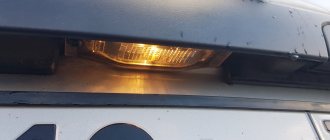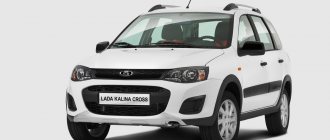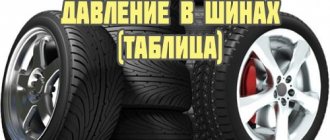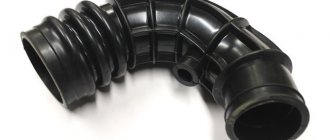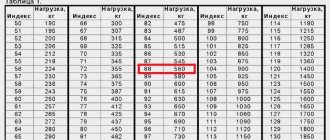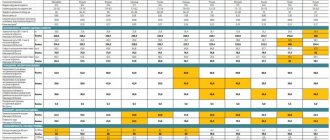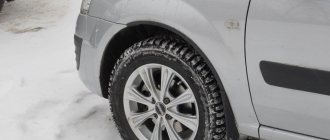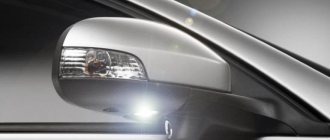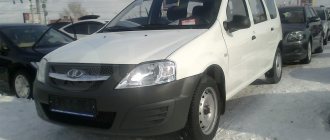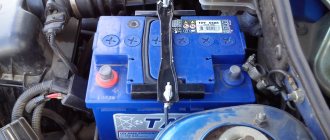Winter is just around the corner, it's time to start shopping for tires. I consider this process extremely important, although many underestimate it, preferring cheap or “popular”, usually just expensive solutions.
Since the car is far from the first and has tried a lot over the previous years, I decided to describe the logic of choice with an analysis of the features of different models. First
, what you should pay attention to is the operating conditions.
It is clear that there are no plans to participate in any races (read rally sprints) in Largus; there will be long intercity trips in any weather, but the main plan, like most, is to use it around the city. Winter looks different in different areas, but in the Moscow region temperatures around zero prevail, with an average amount of snow. Street surfaces in 95% of cases are asphalt. from pure dry to reagent porridge. Heavy icing and deep snow are possible in yards. The second
is the price of the issue.
Quite a long time ago, having tried Gislaved NF3, I became ingrained in the opinion that good tires in winter are not just important, they are necessary. Therefore, it is undesirable to save, although in some places it is possible, but not about that yet. The main thing I would like to say here is that you should prepare to buy not the cheapest NEW tires. The remaining options are practically unacceptable; ideally, you won’t be able to find a 1-season used one on sale significantly cheaper than a new one, and rolling a hard used one with a tread depth of less than 5-6mm and older than 4-5 years is unacceptable. Third
is the choice of brand. With their own characteristics, only Nokian, Continental (Gislaved), Michelin and, probably, some Goodyear models are reasonable to buy (I haven’t tried it from personal experience, but they perform well in tests). The Koreans and Japanese still haven't learned how to make good winter tires. I’m generally silent about China and domestic brands; using this is dangerous for the psyche and health in general. There is no question of dimensions for civilian use; they are recommended by the factory, preferably with the minimum (of the recommended) disk diameter. Directional stability on asphalt in winter is not at all relevant and all these tire breaks will not be noticeable in any way. But a higher profile will provide better softness and resistance to tears and hernias on roads broken in early spring. However, if the disks are already there and a simple re-flashing is in progress, then this issue is removed.
Let's move from theoretical layouts to specific values and models.
I have used: Niishp-rally (without spikes), Gislaved NF3, Nokian Hakkapelita 4, Nokian Hakkapelita 7, Yokohama IG30 (without spikes).
Certain points are worth considering carefully: 1.
Tires get better over the years, comparing a 25-year-old snowflake with any modern one is stupid.
But the difference in progress between models of 8-10 years ago is no longer so significant, for example, in sprints, I remember Gislaved lost 4 hacks, but not for an eternity. And 4 hacks lost to 7, and quite a bit. For normal civilian use, this difference of 2-3% is ISNESSIBLE! The main thing: that all these are already GOOD tires, and even a half-toothless Gislaved gave a feeling of confidence on an icy and snowy road. You could be allowed to drive as you pleased (adjusted for winter, of course). From which I draw my first conclusion: There is no need to chase the most modern models! (especially in sprints, as far as I know, 8 Hakka does not beat 7 at all). 2.
Spikes or not spikes... The question is the most controversial and difficult.
If a person doesn’t drive much, drives a car with good noise, and also has little winter driving experience, then it’s most likely worth taking a stud, no matter what. But my situation is different. Here we again return to the progress of winter tires. If the Niishp rally on ice turned out to be simply helpless (almost like an all-season rally), then even the weakest Yokohama (according to tests, it sucked) did not completely lose contact and was slightly controlled. Here I decided to take a little risk and try to carry out a long operation of a modern SCANDINAVIAN type tire WITHOUT studs. If on bare ice it is at least one and a half times better, then this is already acceptable... but 99% of operation is asphalt or compacted snow, where there is no difference in grip. But the lack of noise is worth a lot! Having driven a non-spike for 2 seasons, I don’t have the slightest desire to listen to the clicking of nails again =) In general, I repeat, the question is not clear-cut, but after thinking about it, I considered this option more suitable for daily driving! However... 3.
... Non-studded shoes also come in different types.
European, like Yoko was... and Scandinavian. So the tread height is a plus! it has good cross-country ability and Yokohama had problems with it. Accordingly, if you sometimes travel out of town, this factor becomes very significant. 4.
The choice of brand was again carried out within the framework described above. Here it is worth noting the worse cross-country ability of Michelins and the traditional flying out of studs on Gislaveds (although this has probably been corrected on the new model using Conti’s gluing technology). The rest is personal experience with Hakki. The rubber is durable, anything can happen.
Source www.drive2.ru
Reading time: 5 minutes
Winter wheels on Largus are those products of various sizes that can be selected without any problems. Even novice motorists should not have any problems with this task. In this matter, the main thing is to decide on the optimal tire sizes, manufacturer’s brand and required characteristics. Unlike summer tires, for winter tires you do not need to worry about the size of the products themselves. On the contrary, it needs to be reduced as much as possible.
The presented Lada Largus Cross car from the AvtoVAZ concern, regardless of the year of manufacture, is a station wagon model and is equipped with cast wheels or stamped steel wheels in the basic versions. Steel ones are quite rare; cast versions are more common for this brand. The parameters, characteristics and recommended sizes of original winter tires must correspond to those established by the manufacturer.
Wheels for Largus Cross, winter
Rating of the best all-season tires for Lada Largus
Tigar ALL SEASON
Description of the tire. Properties are balanced for year-round use. The pattern of the central part of the tread is in the form of a fish skeleton.
It allows you to effectively remove water, slush, and dirt from under the tire. The risk of aquaplaning is reduced and maneuverability is increased.
Powerful tread blocks on the shoulder areas increase traction, improve cornering, and shorten braking distances on wet and dry asphalt.
Rubber contains silica. Thanks to it, adhesion to the road improves and fuel consumption decreases.
The sidewall is soft and elastic. This allows you to move on the worst roads quite comfortably, because... tires absorb vibration and shock.
But it’s better not to rub against the curb - there is a high risk of tearing the tire.
- Good cross-country ability in slush and mud.
- Not afraid of aquaplaning.
- Budget cost.
- Well absorbs shocks and vibrations on bad roads.
- Shock resistant.
- Soft.
- Well balanced.
Users note that this tire is well suited for those who do not want to change tires in summer and winter.
Summing up
Purchasing and installing winter tires on Largus or Largus Cross allows you to maintain maximum vehicle handling in winter. Of course, even the highest quality winter tires do not guarantee excellent driving in icy conditions. You should choose tires for winter based on the following parameters:
- Stability on ice.
- Hydroplaning.
- Speed qualities.
- Price.
- Brand.
The presented criteria will help you choose the most suitable copy of the Lada Largus. In winter, tires should help with handling, cope well with slush, and also not break the budget. The brand of rubber is not particularly important, due to the constant updating of the product line.
Source
Rating of the best summer tires for Lada Largus
Belshina Artmotion
Description of the tire. Manufactured in the Republic of Belarus. Three longitudinal channels and a network of notches do a good job of removing water from the contact patch.
Traction and grip properties are stable. Handling is easy on dry and wet roads. Rolling resistance is reduced, which improves fuel economy.
Zigzag notches in the central part of the tread contribute to stability on the course, and powerful blocks on the shoulder areas improve cross-country ability and promote confident cornering.
One of the reasons for its popularity is the budget price. The tires are really inexpensive compared to analogues from famous brands.
The structure is reinforced with a steel cord breaker, which gives it strength.
It feels good on bad roads, is not afraid of impacts, but the sidewall is a bit harsh, so it is quite noisy. Slips on mud and wet grass.
In general, the model is suitable for a quiet ride without excessive dynamics.
- Inexpensive.
- There is a side to protect it from contact with the curb.
- Well balanced.
- Confident handling.
- Not afraid of potholes.
- Good braking performance.
KAMA Breeze
Description of the tire. Directional tread pattern.
Four longitudinal grooves ensure rapid drainage of water from the point of contact with the surface, removing it through a network of grooves. This significantly reduces the risk of hydroplaning.
A solid rib runs through the center, thanks to which directional stability is maintained.
Tires are not for dynamics, but for quiet driving. They hold the road well, brake effectively, including on wet roads, and are quiet.
In general, a confident average car that can be driven on good and broken roads, as well as dirt roads. You can even drive into a little mud.
Wear resistance is not bad, with quiet operation it lasts 4-5 seasons. But you shouldn’t expect anything special from them.
The main attractive feature is the very low price. The entire set can be purchased for the same price as one wheel from a famous brand.
- Very inexpensive.
- Wear-resistant.
- Good handling.
- They are not afraid of ruts.
- Not prone to hydroplaning.
- Not loud.
What size and wheel alignment angles for Lada Largus
How long do Velcro winter tires last?
Product size
Increasing the width of the products themselves will also have a positive effect on road holding, on the accuracy of car control, grip on dry roads will become better, and driving on uneven roads will become more comfortable. However, resistance to aquaplaning will deteriorate, noise will increase, fuel consumption will increase, and the tires will wear out faster.
The car is equipped with original 15-inch parts manufactured by Magnetto Wheels.
On the Lada Largus the wheel parameters are as follows: 6×15/4×100 D60.1 ET50:
- width - 6 inches;
- bolt pattern - 4×100;
- standard diameter - 15 inches;
- diameter of the central hole - 60.1 mm;
- the offset is 50 mm.
About winter tires on Lada Largus Cross
Winter wheels on Largus are those products of various sizes that can be selected without any problems. Even novice motorists should not have any problems with this task. In this matter, the main thing is to decide on the optimal tire sizes, manufacturer’s brand and required characteristics. Unlike summer tires, for winter tires you do not need to worry about the size of the products themselves. On the contrary, it needs to be reduced as much as possible.
The presented Lada Largus Cross car from the AvtoVAZ concern, regardless of the year of manufacture, is a station wagon model and is equipped with cast wheels or stamped steel wheels in the basic versions. Steel ones are quite rare; cast versions are more common for this brand. The parameters, characteristics and recommended sizes of original winter tires must correspond to those established by the manufacturer.
Wheels for Largus Cross, winter
DIY tire replacement rules
In order to save money, many car enthusiasts are thinking about replacing tires themselves. The process is not the easiest, but doable. To work, you will need a balloon, mounting blades, a jack and a compressor or pump. When performing the procedure, you should take into account some tricks, without which this event is doomed to failure.
Removing the tire from the rim
First you need to remove the wheel from the hub. Then it is laid on the ground so that the nipple nipple is at the top. All the air is released from the tube or tire, in the case of a tubeless tire, and the nipple nipple is recessed inside. You need to stand on the wheel with your feet so that the edge of the tire separates from the rim of the disc. Sometimes extra force may be required if the rubber sticks to the metal.
A mounting blade is inserted into the gap between the edge of the tire and the disk, then a second one. The main task is to turn the sidewall of the tire beyond the edge of the rim. If the wheel has a tube, it is pulled out through the resulting gap. If the tire is tubeless, you need to unscrew the entire side of the tire by the rim, then unscrew the second sidewall of the tire using the same edge of the rim and remove it from the rim.
When working, you must apply considerable force and be careful not to damage the disc. Cast products made from light alloy materials are especially fragile.
Mounting a tire on a rim
Before installation, make sure that the tire is the correct size and has no defects. It is recommended to remove the balancing weights and the old nipple. When installing, you should take into account the markings on the tire, usually the direction of travel in the form of arrows.
To facilitate the installation task, you can apply a soap solution to the edge of the tire and the rim of the disk, but within reasonable limits, otherwise the tire will slip. Installation is carried out in the reverse order of removal. First, one edge of the tire is put on, after which the second one is wound on the rim.
Tire pressure and inflation
For wheels with a tube, everything is simple - you need to inflate the tube more than required in the manual (the pressure in Largus tires is no more than 2.1 atmospheres). This is necessary so that the tube sits evenly in the tire, after which you can deflate the air to the required values. For a tubeless tire the process is more complicated. When you try to inflate it, air will escape through the gap between the edge of the rim and the sidewalls of the tire.
You need to inflate any other wheel to 4 atmospheres. After this, remove the hose from the pump and put the end without a fitting on the nipple of the installed tire, the other end with a fitting is put on the inflated tire. Air under high pressure and at high speed will quickly fill an empty tire. This will be enough for it to sit tightly on the rim without having time to let air through the gaps. But it’s better to go to a tire shop, where this procedure will take a few minutes using special equipment. After the procedure, you will need to balance the wheels, which cannot be done in a garage without a machine.
Unlike all previous AvtoVAZ models, larger wheels are initially installed on Largus. This way, this model further emphasizes its relationship with other brands. Lada Largus is a joint product of AvtoVAZ and the Nissan-Renault concern.
Source expertvaz.ru
Winter tires for Largus: tips
The Lada Largus Cross is a car built on the basis of the Dacia Logan and rebuilt for the needs of the domestic market. It is a joint project between the two and Avtovaz to expand the presence of both brands on the Russian market. Produced since 2012. Over the entire period of production, it has gained quite a large number of fans due to its versatility, relatively reasonable price and high level of quality. Produced in five- and seven-seat versions. There is a model in the form of a cargo van or a passenger station wagon. The “Cross” version is the most expensive and sporty. Alloy wheels and many other interesting things are installed on it.
Like any other car, the Largus Cross is subject to tire wear or the need to replace them due to the change of season. Regardless of the reason, tire replacement should always occur in a timely manner. It is important that the new set of tires matches the old one in diameter and width, otherwise the products will not install on the wheel rim. In any case, you need to timely, efficiently and correctly select a new set of winter tires from the large assortment of products presented in stores. The characteristics of products can differ radically, so the choice should be of the highest quality possible.
Selection of discs
Sometimes, along with the tires, the rims also need to be replaced. The factory version is presented in the form of a 16-inch sample and is installed on absolutely the entire automobile range of the brand. If replacement is necessary, for example, new tires on Largus Cross or a failed (damaged) disk, it is recommended to install a similar one in size. The parameters must be accurate, which will extend the life of not only the disk itself, but also protect the driver.
Not all car enthusiasts follow this rule, trying to install wheels according to the principle of a spectacular appearance. This will not improve the driving performance of the vehicle, but it will definitely cause problems. The essence lies in the factory specifications, which are adjusted to every detail of the car. This is the permissible rim width, diameter, number of holes for bolts, as well as the distance between the latter. Neglecting this rule can cause the following problems:
- car suspension wear;
- the risk of not receiving warranty service;
- problems in the chassis;
- safety and vehicle control.
Thus, if winter tires on a Lada Largus Cross require replacement, you should also worry about the rims. It is worth choosing based on parameters and technical data, and not on an attractive, external effect. Otherwise, this may lead to a number of malfunctions, an emergency situation on the road, and, as a result, monetary costs for repairs.
Winter tires for Largus Cross: which ones to choose
If for most of the year the roads in the area are in poor condition, are not cleared of snow and are regularly covered with ice, then the most optimal option would be to use studded tires. However, it should be remembered that this type is completely useless on asphalt. If the car is used more often on normal roads in the city, then such tires will only wear out a lot. Their spines will quickly wear off or fall off.
In a city where the roads are often and quickly cleared of snow and are in decent condition, a regular Velcro is more suitable.
Winter studded tires on Largus
Frequency of checking tire pressure
The tightness of the wheel structure is not ideal. The air gradually comes out. The reduction in pressure directly depends on the air temperature.
Monitoring must be regular. It is optimal to check your blood pressure at least twice a week. Ideal when leaving a parking lot, visiting a gas station, or performing maintenance.
The measurement should be carried out before the tires heat up (for example in the morning) in all wheels, even in the spare wheel. Checking along the way will not give accurate indicators.
The pressure in the tire should be lower than in the other wheels.
Visual assessment of the condition of tires is an irresponsible attitude towards the vehicle and safety. There is a high risk of not noticing a slight decrease or increase in pressure (0.1-0.5 atmospheres).
It must be remembered that temperature fluctuations and vehicle loading lead to changes in the indicator.
In the following situations, it is recommended to reduce the atmosphere to a level lower than the factory instructions:
- when driving on a slippery road (in winter);
- for off-road driving.
The best winter tires for Renault Largus
2021 rating of the best winter tires for Renault Largus, studded and non-studded (Velcro) for passenger cars, according to reviews from motorists and assessments of independent experts on the website. Summary technical characteristics of tire models (speed index, presence of studs, diameter, profile width and height), pros and cons, reviews and tests, comparison of prices in sales companies and online stores in your city with the ability to buy with delivery and pickup.
The controllability of a car on a dry or snowy track (deep snow) depends on the quality of the rubber, which should ensure safe control (driving), effective braking and stability on the road (even on uneven surfaces). Winter and summer tires (depending on the season) have a special sipe structure, grooves and a directional tread pattern (provides a dry contact patch), a durable sidewall (shoulders), which is necessary for comfortable driving in specific conditions.
The composition of rubber includes silicon and polymer mixtures, which ensures wear resistance, as well as maintaining rubber elasticity at a certain air temperature (high, low). The choice of tires is made taking into account the model of a particular car. Choosing the right tires will ensure low fuel consumption and confidence when cornering at high speeds.
The special composition of the rubber mixture, combined with a thoughtful shape, gives the machine directional stability and wear resistance. A large selection of new tires allows you to choose the right model for a wide variety of and difficult conditions of use. This ensures minimal braking distance even on slippery surfaces. With the right tires, the car will not drive on the road.
The following tire sizes are suitable for Renault Largus:
Source
What to avoid
The climate in Russia rarely indulges in mild winters. Usually at this time, the weather is dry or wet snow, sometimes with rain, which causes ice on the road. Many car enthusiasts try to save money on winter tires by replacing them with an all-season equivalent. But, as practice has shown, this is a dubious method. All-season tires are absolutely not adapted to cold, humid climates, which will practically not provide the necessary grip on icy surfaces. In addition, it is fraught with an emergency situation. Automotive experts agreed on one opinion - the tires on Largus should be winter.
What non-standard sizes can be supplied?
Buy tires based on the full diameter of the wheel. It shouldn't be too different from the standard one.
Standard sizes allowed for installation.
| Model | Size, load capacity index | Center diameter wheel holes (DIA) | Radius between holes (PCD) | Number of nuts, pcs. | Wheel width, inches | Disc offset (ET) |
| R90 | 185/65R 15 88 H | 60,1 | 100 | 4 | 6J | 50 |
| F90 | 185/65R 15 92 H | 60,1 | 100 | 4 | 6J | 50 |
| CROSS | 205/55R 16 91 H | 60,1 | 100 | 4 | 5 ½, 6, 6 ½ J | 50 |
| Parameter | Increasing tire width | Increasing rim width |
| Keeping the car on the road | will improve | will improve |
| Accuracy of maintaining a given direction of movement | will improve | will improve |
| Road grip coefficient | will increase on dry roads | does not affect |
| Resistance to aquaplaning effect | will get worse | without changes |
| Traffic noise | will intensify | does not affect |
| Feelings when driving on rough roads | more comfortable | does not affect |
| Fuel consumption | will increase | will increase |
| Tire wear time | will speed up | without changes |
Be sure to calculate the load capacity index. Depending on the model, 88 (560 kg), 92 (630 kg) and 91 (615 kg) are allowed. The speed index is indicated next to the load capacity. T – up to 190 km/h, H – up to 210, V – up to 240.
An approximate formula will come in handy. Calculate the mass of the car, the weight of all possible passengers and cargo. Divide by 4 (wheels). Add a little extra.
Important! Installing large wheels can lead to incorrect operation of the ABS and electronic dynamic stabilization system of the vehicle. The lighter the tires and wheels, the faster the vehicle accelerates.
So, a car will accelerate to 100 km/h 0.2 seconds faster if the wheel weight is 2 kg less
The lighter the tires and wheels, the faster the vehicle accelerates. Thus, a car will accelerate to 100 km/h 0.2 seconds faster if the wheel weight is 2 kg less.
Options
The AvtoVAZ concern added the Cross prefix to the model name for a reason. It is understood that the model has increased off-road capabilities.
The car's ground clearance was increased and the base wheels were installed a size larger than those of the base model. There are no options for replacing R16 disks with others.
The parameters of the basic wheel rims are as follows:
- drilling parameter is 4×100;
- wheel width - 7.0 J;
- disc offset is ET 40;
- centering hole size - 60.1.
Knowing all the various methods for producing wheel rims and their advantages, you can choose a set of quality products for Lada Largus. In order for the disc to fit perfectly, you also need to know the basic parameters and dimensions of the mounts.


